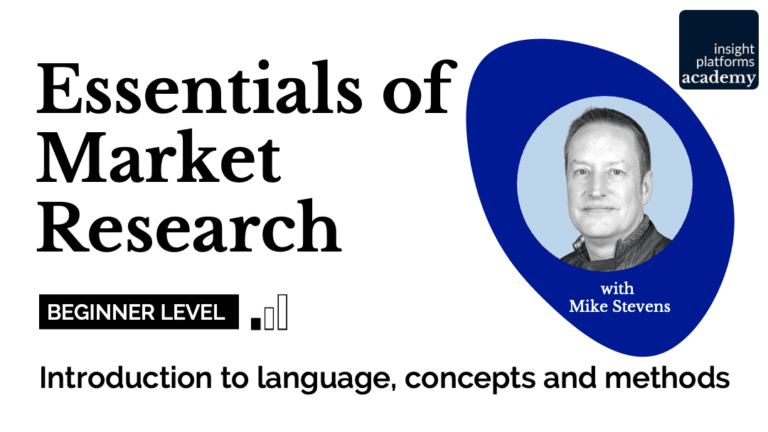What is Market Research?
What is Market Research?
So you’ve heard the term “market research” thrown around, but what does it really mean?
This explainer gives you the basics. It is for anyone new to market research, and will give you a quick breakdown of the most common approaches and key terms you will encounter.
If you’re a marketer, product manager, startup founder or anyone else who needs a crash course in the basics, check out the Insight Platforms Academy course Essentials of Market Research:
Essentials of Market Research
In a nutshell, market research is a way to get a glimpse of what customers think, need, want and do. We are not our customers – despite the way many brands might think.
It doesn’t matter whether you’re selling a physical product or an online service – you need to know what people want (or if they want it at all) before you start making anything.
So, Why should I do Market Research?
The list can be quite long, but the most common uses are:
- It provides valuable information about your customers, market and industry.
- It validates new product ideas.
- It provides feedback on your brands, products and services for improvement or further development.
- It helps you understand how you measure up against competitors and their actions.
- It predicts the likelihood of success of your products before you invest time, money and resources developing them.
- It helps you find new opportunities through gaps in the market, underserved customer needs or trends from other industries that can be applicable to yours.
Where to start doing Market Research?
A market research project framework usually involves:
The Briefing: outlines problems, hypothesis and the decisions results will influence.
Planning: defines the objectives, methods and sample.
Data Gathering: comprises fieldwork, data quality and processing.
Analysis: confirmation of hypothesis, the framework of findings and tools to solve problems.
Report: the form used to inform, engage and influence stakeholders to make decisions.
Although there are many methods and tools for doing Market Research, there are two main branches to choose from: quantitative and qualitative, which will be outlined below.
Quantitative Market Research
Quantitative market research gathers feedback from many people at once, using the same questions for everyone.
It is used for measuring how many people think the same way. It requires a large sample (a group of people) to represent everyone, and results in numbers and percentages rather than individual opinions and nuances.
One of the most widely used methods for quantitative data collection are surveys, which can be online and offline. And results are mostly drawn in percentages, numbers, tables and graphs.
Quantitative market research is ideal for:
- Innovation Development: testing ideas, products, price and packaging before market launch.
- Advertising Testing and Tracking: getting feedback on ads’ format, content, credibility or branding to make improvements before spending money on airing them, or to make improvements on existing ads to increase their performance.
- Audience Profiling: understand who are the people that are more likely to buy your products and services.
- Managing Brands: understand what consumers think about market, brands and competition, find out what can be improved or developed to boost them and the effect of marketing actions in building brands.
- Measuring Experience: getting feedback on what customers, users or even employees think of your products, services and companies. It helps developing and correcting new routes that will improve their opinion and increase loyalty.
- Shoppers’ Activation: understand marketing activities that can influence higher number of people to choose specific brands and categories.
These are the most common uses in marketing, however there are many others, like opinion polls, social research etc, that are widely used in NGOs, Government departments and public bodies to understand the communities and help policymaking.
Qualitative Market Research
Qualitative Research uses conversation or observation to understand people’s needs, attitudes and behaviours, independently of how many of them are alike. The objective is not to measure sizes, but to understand individual nuances and attitudes.
This type of market research is talk-based and involves in-depth interviews with customers or potential users (or even just people who aren’t even customers yet) to get a detailed glimpse at what they think, do, feel and care, when thinking about your market, products, services or brands.
It uses conversation-like techniques, with flexibility to adapt and change, to explore themes, experiences and emotions in depth as they arise.
Qualitative data collection can be online or offline, with individuals or groups, as long as each participant can have a say, even if it is not a common agreement.
Qualitative Market Research is ideal for:
- Innovation Development: expanding vague ideas into features, generating new ideas and hypothesis.
- Advertising Evaluation: getting early stage feedback on advertising ideas, understand reactions and potential issues like misunderstandings before airing, evaluate campaigns that are not doing their job or are affecting the company negatively.
- Audience Profiling: explore how different demographics, segments and groups behave and think about your products, services and brands.
- Brand Management: understand how people perceive and feel about brands, companies, services or products.
- Product Development: gather strengths and weaknesses of products, services and brands for improvement.
- Shopper Understanding: understand triggers and influencers of choice of channel, brands and categories for sales strategy making.
As you have noticed, both can be used for similar types of information, but the choice of which to use is based on the type of results you are looking for and the stage of your issues.
Qualitative and quantitative research are not exclusive – more often than not, they’re run in succession or asynchronously. Depending on project specifications, researchers may decide to stick with one method, or start with qualitative and finish with quantitative or the other way around.
Advanced Market Research
In recent years, there has been an explosion in new market research methods.
Behavioural Science approaches help people understand what really motivates them – beyond simply asking questions. Technology- enabled neuroscience methods help researchers learn about people without necessarily talking to them. ‘Big data’, social media listening and digital analytics have all been incorporated into market research approaches as well.
Here are just some of these more advanced market research methods.
Social Media & Search Intelligence
It means analysing what’s said about your organisation, products, or competitors on social media. It helps to understand your audience, their tone, and interpret their emotions to create actionable insights.
Biometrics
Techniques that analyse and interpret body language, biological functions, and the most used, facial expressions and eye movement, to understand what they feel and think, without asking them.
Digital And Passive Tracking
Digital tracking involves collecting consumer information through digital devices (i.e.: tvisited websites, apps dowloads, cookies etc.). Similarly, passive tracking uses cameras, microphones and GPS data to record what people do in public spaces (i.e.: stores and restaurants). Both follow consumers footsteps online and offline, to understand their journey, behaviours and habits.
Video Research
Videos show consumers behaviour in details, even things they don’t rationalize or don’t notice, giving raw insights that wouldn’t come from interviews.
Voice Analytics
Analyses the tone of voice, intonation and breathing patterns to provide people’s sentiments, thoughts and emotions.
Behavioural research can be used to understand how people make decisions, what motivates them, and how they perceive certain brands as well as to create better products, services and customer experiences. However, on their own, they can be misleading or incomplete, as they offer what people do, but not why they are doing it.
What Happens Without Market Research?
Even with the increasing availability of many forms of Market Research, many companies still skip this important step within their marketing activities. Mostly due to time, money or resources constraints – but many end up finding that skipping it leads to much higher costs for their products, brands and companies.
Here are some examples of companies that launched products without doing their due diligence
Microsoft Zune
Microsoft launched its Zune music player in 2006 as an alternative to Apple’s iPod line of portable music players which had already been on the market for 5 years at the time. The release was not only bad timing, users also found it difficult to navigate through menus and playlists due to a lack of buttons on its touchscreen interface. Additionally, there weren’t any apps available for the device, and users were unhappy with the device’s poor battery life and generally slow interface. The product was discontinued in 2011 after sales failed to meet expectations.
Sony Reader
Sony’s e-reader launched in 2007 with a hefty price tag and was far more expensive than Amazon’s Kindle at the time. The device also lacked Wi-Fi connectivity—a key feature that made Amazon’s device more attractive to consumers looking for an easy way to download new books online without having to buy them from brick-and-mortar retailers. Amazon also ran an expensive and effective marketing campaign to generate awareness of e-readers. Sony eventually dropped the price of its Reader, but by then it was too late. The company stopped making new Readers in 2012.
You don’t need to be a product designer to know that not doing market research before launching a new product is a recipe for disaster.
McDonald’s
McDonald’s venture into “healthy foods”: In 1948, McDonalds only served nine different dishes, but today it features over 100 different items. In 2015, the fast food chain introduced salads and oatmeal in an attempt to attract customers who were looking for healthier options. Unfortunately, these products were priced much higher than their regular menu items and had no real differentiation from other brands in the category. A year later, in 2016, research suggested that while people do like the idea of healthy food, they are not looking for any in fast-food joints like McDonald’s. Regardless, the company keeps on pursuing healthy food items in an attempt to cater to more consumers.
Conclusion
Market research is not just about collecting data – it’s about connecting with people on a deeper level, to understand their needs and issues that can be solved with your brands, products and services.
Insights help driving strategies for new product development, improving existing products/services and it’s an important tool for companies looking to stay on top of the game.
Learn more:
Essentials of Market Research
Sources
https://www.businessinsider.com/why-sonys-reader-failed-and-how-it-plans-to-fight-the-kindle-2009-8
https://medium.com/@justinfussdesign/microsoft-zune-a-case-study-in-failure-c21bc1f62222
https://www.mashed.com/176406/mcdonalds-has-made-some-pretty-bad-decisions/

